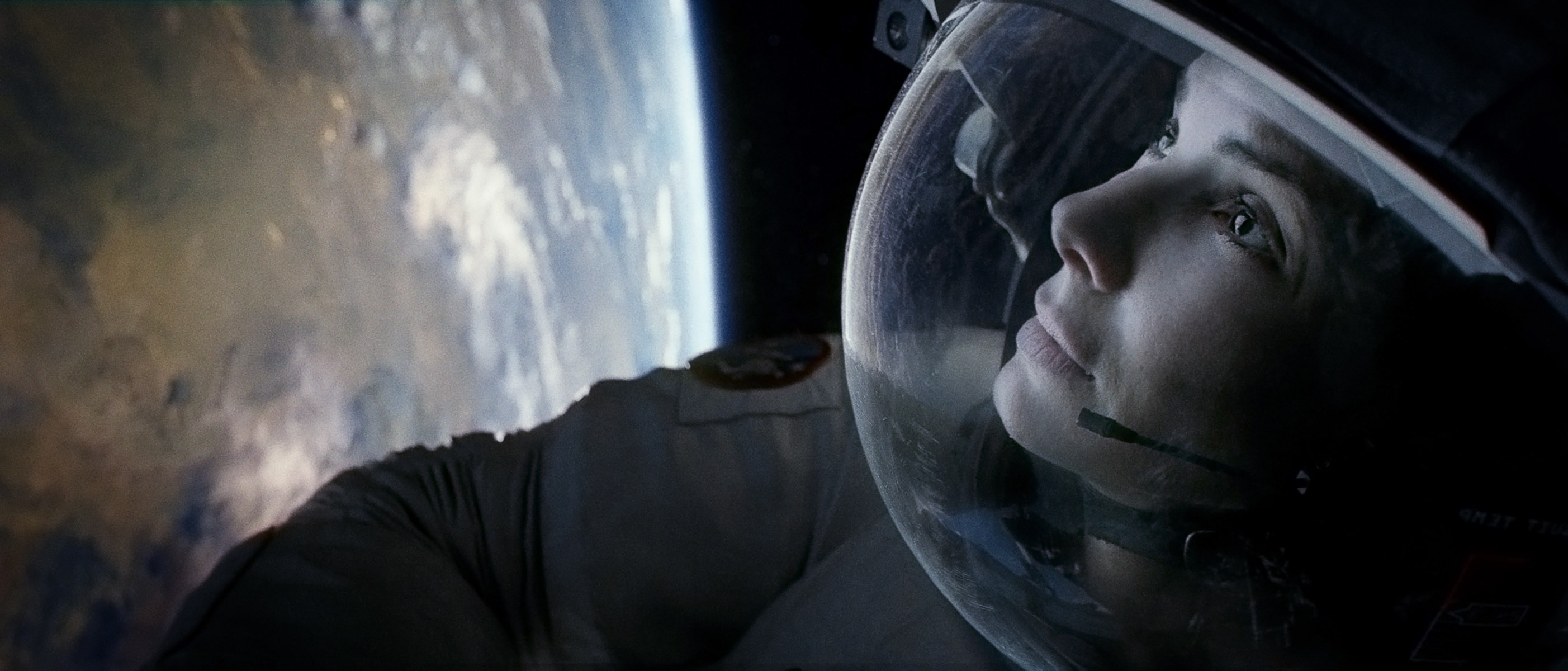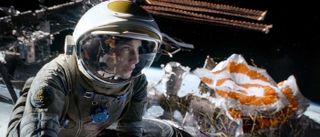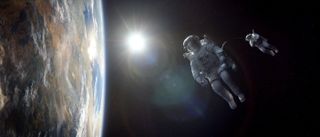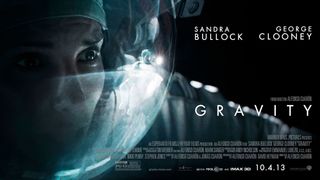In 'Gravity,' Sandra Bullock Gives Space a Human Heart, Finally (Commentary)

You’re not supposed to cry at space movies. That's just an understood truth of the genre. Astronauts must suppress feelings. But if you don't leak at least a cubic centimeter of sodium chloride solution while watching "Gravity," your heart is clearly made of titanium.
Sandra Bullock will crack your emotional armor with her performance as Dr. Ryan Stone, a talented but withdrawn rookie mission specialist during a real bad day in space. She will make you cry in empathy, in joy and in frustration. She'll make you giggle, recoil and cringe too. As her character fights to stay alive, she comes alive inwardly as well. Stone becomes less stony.
All parents take note: This story hits close to home.
To keep an audience hard-docked to the inner emotional life of a character, as she transforms radically, may be the ultimate challenge in filmmaking. It's much harder to pull off than any special effect. Bullock's performance in "Gravity" is the kind of actor's tour de force that comes along maybe once in a quarter century. [See photos from the space film "Gravity"]
Yes, Sandra Bullock is that good.
Her character is strong, and weak, outwardly bulletproof and utterly vulnerable. To say her Dr. Stone has gravitas is too lightweight an idiom. But she is not at all one of those righteously stuffy fly-girls you've been led to expect.

The right stuff is wrong
Get the Space.com Newsletter
Breaking space news, the latest updates on rocket launches, skywatching events and more!
Astronauts are not supposed to be emotional. If things go south, space crew are encouraged to stay stone cold and work the problem; don't clutter the "Comm" with loose chatter. Keep rational focus. But real people — in real life-and-death situations — seldom behave this way. A large body of behavioral research shows that we tend to make better survival decisions when the head and the heart are both fully involved. ["Gravity's" Astronaut Advisors: Fears and Family in Space (Video)]
NASA cast its entire culture in the persona of its early test-pilot astronauts. In the space agency's public-facing universe, acronyms are cool, emotions are not. An overabundance of self-control and compartmentalization was long considered the mark of space professionalism.
Real astronauts are real people however and, in this reporter's experience, not a bit like this icy-image in real life. But you'd never know it from NASA Public Affairs Officers' propaganda. No wonder two generations of taxpaying Americans feel alienated from their space program.
Sandra Bullock will change your mind about all that. If you've seen "Gravity's" nerve-wracking trailers, you know you're in for a wild cinematic special effects ride. What you may not be prepared for is the emotional roller coaster.
As Bullock's Ryan Stone persona works through all the stages of confronting tragedy, Bullock will shift your vectors of emotional inertia completely around. She will completely suspend your sense of clock time, even as she convinces you that you're suspended in low-Earth orbit beside her. She'll get you in a place where your guts control the tempo; where you evolve from heartbeat to heartbeat.
She can be so excellent thanks to a startling story by the father and son team of Alfonso and Jonas Cuarón. As Bullock told me, "Gravity" is a very personal story for the Cuarón family, which juxtaposes a mother figure floating above and separated from the ultimate Mother Earth. Alfie, as he's known, directs.
"Gravity" orbits in a ring of truth
Beyond Bullock's craft, and the Cuarón's story, the film works so well because there is no moment where you doubt its truth. Authenticity, apparent in every prop, costume and set piece, matters even to audiences who don't geek out on space hardware. The filmmakers spent an enormous amount of expense on matching — then extending in subtle ways — the exact appearance of NASA's space shuttle, the Russian Soyuz and the International Space Station inside and out.
I could tell you that some sets were built in sections, moved in and out in real time as camera was rolling around Bullock and supporting actor George Clooney. But you won't notice. You'll just be convinced your eyes are floating in and out of spacecraft with Dr. Ryan Stone. [Making Gravity: How Filmmaker Alfonso Cuarón Created 'Weightlessness' (Video)]
And that's the whole point.

A body in motion
Motion, too, must be perfectly "spacey" or the film's illusion is instantly blown. This required Bullock to train and tone to a place where she can convince you of weightlessness just through an exquisite degree of body control. She had to unlearn certain actors' tropes of movement that assume a gravity vector. She had to carefully research the very different way the human body moves in microgravity.
"I had to retrain my body to react in the way it would react in space," Bullock said in a statement. "Every single part of my being had to be used to execute zero gravity in a way that was poetic and lyrical."
For some scenes, Bullock literally became a puppet. The effects team created a unique servomotor-controlled 12-wire rig clewed to a carbon-fiber harness custom-molded to Bullock's body contours.
But unlike any previous puppet, Bullock herself ultimately commanded this rig. She could cue the puppeteer crew with a subtle head or shoulder gesture, which informed and motivated her path of travel. (Watch for this in scenes on the International Space Station — but wait until your second "Gravity" viewing; first time through just take the ride with her.)
Space turns people green
Making "Gravity" changed Sandra Bullock. Space changes astronauts. Pilot-astronauts in particular (CDRs and PLTs) tend to come from military backgrounds where ecological sensitivity is not, shall we say, a requirement on the resume. Yet nearly all of these steely-eyed missile men and women return from their first trips to orbit as ardent environmentalists.
"I used to think astronauts wanted to go into space for the thrill and adventure," Bullock said. "When I spoke to them, though, I was so moved by their deep, deep love of that world and the beauty of Earth from their perspective."
She also appreciated their photographic abilities. Many astronauts are remarkable photographers, able to bring a planetary perspective down to Earth. "What blew me away is how they are able to show off this world of ours," said Bullock. "I'd never seen it before and felt guilty that I had never appreciated it as much as I do now."

Force of "Gravity"
Gravity is more than an irresistible physical effect of mass. It's the power behind re-entry of Bullock's character into the human community. The film tracks at least three of the primal seven great plots of literature. It's at once, "voyage and return," and "death and rebirth," and a bit of "mythic quest" as well.
The metaphor of choosing to be cast out, by rocket launch, from the protective cradle of Earth — then having to fight her way back in — lies close to the core of Bullock's performance motivation. "It's a story about what makes us try when it seems there is no light at the end of the tunnel," she says. "What is it that makes you go that extra step, just in case it was worth the effort?"
The same could be truly asked of all inquisitive exploration, and especially of our forays beyond mother Earth into space.
Epilogue: Echoes of Sally Ride
America's first female astronaut, Dr. Sally Ride (May 26, 1951 – July 23, 2012), was also the first President of SPACE.com. She worked tirelessly to break the "glass ceiling" for young female scientists, engineers and students wishing to pursue challenging careers. Sally fought to protect our home planet. But she also wanted young women’s opportunities to be as big as the Universe.
We cannot speak for Dr. Ride, but based on her editorial guidance in the time she was our boss, we believe Sally would have strongly approved of the Dr. Ryan character and especially of Ms. Bullock's powerfully soulful portrayal. The real Dr. Ride and the fictional Dr. Ryan teach us much about what we humans can be for one another.
Follow us @Spacedotcom, Facebook and Google+. Original article on SPACE.com
Join our Space Forums to keep talking space on the latest missions, night sky and more! And if you have a news tip, correction or comment, let us know at: community@space.com.
Dave Brody has been a writer and Executive Producer at SPACE.com since January 2000. He created and hosted space science video for Starry Night astronomy software, Orion Telescopes and SPACE.com TV. A career space documentarian and journalist, Brody was the Supervising Producer of the long running Inside Space news magazine television program on SYFY. Follow Dave on Twitter @DavidSkyBrody.











